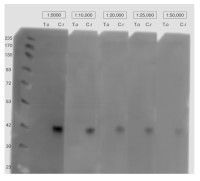1

Anti-Ble tag | Bleomycin resistance protein
AS22 4832 | Clonality: Polyclonal | Host: Rabbit | Reactivity: Ble tag
- Product Info
-
Immunogen: KLH-conjugated peptide derived from Bleomycin resistance protein from Streptoalloteichus hindustanus, UniProt: P17493 Host: Rabbit Clonality: Polyclonal Purity: Antigen affinity purified serum, in PBS pH 7.4 Format: Lyophilized Quantity: 50 µg Reconstitution: For reconstitution, add 50 µl of sterile or deionized water. Storage: Store lyophilized/reconstituted at -20°C; once reconstituted make aliquots to avoid repeated freeze-thaw cycles. Please, remember to spin tubes briefly prior to opening them to avoid any losses that might occur from lyophilized material adhering to the cap or sides of the tubes. Tested applications: Western blot (WB) Recommended dilution: 1 : 5000 - 1: 25 000 (WB) Expected | apparent MW: 13.796 kDa - Reactivity
-
Confirmed reactivity: Ble tag Predicted reactivity: Species of your interest not listed? Contact us Not reactive in: No confirmed exceptions from predicted reactivity are currently known - Application Examples
-

2.5 µg/well of total protein extracted freshly from Tetradesmus obliquus. Exact buffer components were: PBS and denatured with exact buffer components NuPAGE™ LDS Sample Buffer (2X) (Invitrogen) at 95°C 10 min. Samples were separated in NuPAGE™ Bis-Tris Mini Protein Gels, 4–12%, (Thermoscientific) and blotted for 3 mins to nitrocellulose (pore size of 0.2 um), using: iblot 2. Blot was blocked with 7.5 % milk TBS-T for: Overnight/18C with agitation. Blot was incubated in the primary antibody at a dilution of 1:5 000, 1:10 000, 1:20 000, 1:25 000, 1:50,000 for 1h/RT with agitation in 7.5% milk TBS-T with agitation. The antibody solution was decanted, and the blot was rinsed briefly twice, then washed once for 15 min and 3 times for 5 min in TBS-T at RT with agitation. Blot was incubated in matching secondary antibody (anti-rabbit IgG horse radish peroxidase conjugated) diluted to 1:10 000 in for 1h/RT with agitation. The blot was washed as above and developed with a following chemiluminescent detection reagent. Exposure time was 12 minutes using Li-Cor. - Background
-
Background: The Ble tag (bleomycin resistance protein) is an important tool in molecular biology, which enables selection of cells that have successfully integrated a gene of interest. It can be used on algal, yeast, plant, bacterial and mammalian cells. By acquiring resistance to the antibiotic bleomycin, the Ble tag allows easy identification and propagation of genetically modified cells. Bleomycin is a potent antibiotic, which provides strong selection pressure that ensures only cells with the resistance gene survive. - Protocols
-
Agrisera Western Blot protocol and video tutorials
Protocols to work with plant and algal protein extracts
Agrisera Educational Poster Collection - Reviews:
-
This product doesn't have any reviews.


